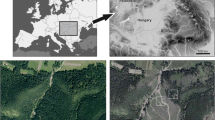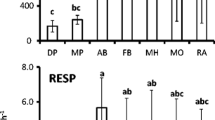Abstract
This study focused on the responses of soil microorganisms to different management regimes on disturbed windthrow areas. Microbial parameters potentially serving as indicators of environmental changes within a long-term monitoring of forest development after large-scale disturbance events were assessed. Basal and substrate-induced respiration, N mineralisation, catalase activity, microbial biomass as well as functional diversity based on Biolog assay were determined in soil samples from three disturbed plots and an undisturbed reference plot in the Tatra National Park (Slovakia) since 2006. A relative congruence of inter-annual trends of microbial activity indicators at all plots results from a common response of microbiota to changes of climate at the landscape level after forest stands were destroyed. While catalase activity and functional diversity proved to be useful indicators of temporal trends, microbial biomass seems to reflect different management regimes at the disturbed plots.
Similar content being viewed by others
References
Alef, K. (1991). Methodenhandbuch Bodenmikrobiologie. Aktivitäten, Biomasse, Differenzierung. Landesberg: Ecomed.
Anderson, T. H. (2003). Microbial eco-physiological indicators to assess soil quality. Agriculture, Ecosystems and Environment, 98, 285–293.
Anderson, J. P. E., & Domsch, K. H. (1978). A physiological method for the quantitative measurement of microbial biomass in soils. Soil Biology and Biochemistry, 10, 215–221.
Barbercheck, M. E., Neher, D. A., Anas, O., El-Allaf, S. M., & Weicht, T. R. (2009). Response of soil invertebrates to disturbance across three resource regions in North Carolina. Environmental Monitoring and Assessment, 152(1–4), 283–298.
Bending, G. D., Putland, C., & Rayns, F. (2000). Changes in microbial community metabolism and labile organic matter fractions as early indicators of the impact of management on soil biological quality. Biology and Fertility of Soils, 31, 78–84.
Bloem, J., Hopkins, D. W., & Benedetti, A. (2006). Microbiological methods for assessing soil quality. Oxfordshire: CABI.
Brejda, J. J., Moorman, T. B., Smith, J. L., Karlen, D. L., Allan, D. L., & Dao, T. H. (2000). Distribution and variability of surface soil properties at a regional scale. Soil Science Society of America Journal, 64, 974–982.
Bormann, B. T., Spaltenstein, H., McClellan, M. H., Ugolini, F. C., Cromack, K., & Nay, S. M. (1995). Rapid soil development after windthrow in pristine forests. Journal of Ecology, 83, 747–757.
Buchmann, N. (2000). Biotic and abiotic factors controlling soil respiration rates in Picea abies stand. Soil Biology and Biochemistry, 32, 1625–1635.
Certini, G. (2005). Effects of fire on soil properties: A review. Oecologia, 143, 1–10.
Čerevková, A., & Renčo, M. (2009). Soil nematode community changes associated with windfall and wildfire in forest soil at the High Tatras National Park, Slovak Republic. Helminthologia, 46, 123–130.
Dilly, O., & Munch, J. C. (1998). Ratios between estimates of microbial biomass content and microbial activity in soils. Biology and Fertility of Soils, 27, 374–379.
Doran, J. W., & Safley, M. (1997). Defining and assessing soil health and sustainable productivity. In: C. E. Pankhurst, B. M. Doube, & V. V. S. R. Gupta (Eds.), Biological indicators of soil health (pp. 1–28). New York: CABI.
Doran, J. W., & Zeiss, M. R. (2000). Soil health and sustainability: Managing the biotic component of soil quality. Applied Soil Ecology, 10, 201–215.
Elkin, C. M., & Bugmann, H. (2009). Climate change induced shifts in forest disturbances and the relative importance to the dynamics of mountain forests in Switzerland. In M. Kaennel Dobbertin (Ed.), Long-term ecosystem research: Understanding the present to shape the future (p. 62). Switzerland: International Conference Zürich.
Gömöryová, E. (2004). Small-scale variation of microbial activities in a forest soil under a beech (Fagus sylvatica L.) stand. Polish Journal of Ecology, 52, 311–321.
Gömöryová, E., Gregor, J., Pichler, V., & Gömöry, D. (2006). Spatial patterns of soil microbial characteristics and soil moisture in a natural beech forest. Biologia, Bratislava, 61, 329–333.
Gömöryová, E., Hrivnák, R., Janišová, M., Ujházy, K., & Gömöry, D. (2009a). Changes of the functional diversity of soil microbial community during the colonization of abandoned grassland by a forest. Applied Soil Ecology, 43, 191–199.
Gömöryová, E., Střelcová, K., Škvarenina, J., Bebej, J., & Gömöry, D. (2009b). Responses of soil microbial activity and functional diversity to disturbance events in the Tatra National Park. In K. Střelcová et al. (Eds.), Bioclimatology and natural hazards (pp. 251–259). Springer Science.
Hackl, E., Bachmann, G., & Zechmeister-Boltenstern, S. (2000). Soil microbial biomass and rhizosphere effects in natural forest stands. Phyton, 40, 83–90.
Hargreaves, P. R., Brooks, P. C., Ross, G. J. S., & Poulton, P. R. (2003). Evaluating soil microbial biomass carbon as an indicator of long-term environmental change. Soil Biology and Biochemistry, 35, 401–407.
Hill, M. O. (1973). Diversity and eveness: A unifying notation and its consequences. Ecology, 54, 427–432.
Insam, H. (1997). A new set of substrates proposed for community characterization in environmental samples. In H. Insam, & A. Rangger (Eds.), Microbial communities. Functional versus structural approaches (pp. 260–261). Heidelberg: Springer.
Islam, K. R., & Weil, R. R. (1998). Microwave irradiation of soil for routine measurements of microbial biomass carbon. Biology and Fertility of Soils, 27, 408–416.
Kandeler, E. (1993). Bestimmung der N-mineralisation im anaeroben Brutversuch. In: F. Schinner, R. Öhlinger, E. Kandeler, & E. R. Margesin (Eds.), Bodenbiologische Arbeitsmethoden (pp. 160–161). Heidelberg: Springer.
Kang, S., & Mills, A. (2004). Soil bacterial community structure changes following disturbance of the overlying plant community. Soil Science, 169, 55–65.
Khaziev, F. Kh. (1976). Fermentativnaya aktivnost’ pochv. Moskva: Metodicheskoe posob’e.
Kirwan, N., Oliver, M. A., Moffat, A. J., & Morgan, G. W. (2005). Sampling the soil in long-term forest plots: The implication of spatial variation. Environmental Monitoring and Assessment, 111, 149–172.
Knoepp, J. D., Coleman, D. C., Cressley, D. A. Jr., & Clark, J. S. (2000). Biological indices of soil quality: An ecosystem case study of their use. Forest Ecology and Management, 138, 357–368.
Lang, K. D., Schulte, L. A., & Guntenspergen, G. R. (2009). Windthrow and salvage logging in an old-growth hemlock-northern hardwoods forest. Forest Ecology and Management, 259, 56–64.
Lindenmeyer, D. B., & Noss, R. F. (2006). Salvage logging, ecosystem processes, and biodiversity conservation. Conservation Biology, 20, 949–958.
Lowe, L. E. (1978). Carbohydrates in soil. In: M. Schnitzer, & S. U. Khan (Eds.), Soil organic matter. Developments in soil science 8 (pp. 65–94). Amsterdam: Elsevier.
Neumann, M. (2009). Environmental monitoring: Examples and recommendations. In M. Kaennel Dobbertin (Ed.), Long-term ecosystem research: Understanding the present to shape the future (pp. 16). Switzerland: International Conference Zürich.
Nielsen, M. N., & Winding, A. (2002). Microorganisms as indicators of soil health. NERI Technical Reports 388.
Patra, D. D., Brookes, P. C., Coleman, K., & Jenkoinson, D. S. (1990). Seasonal changes in soil microbial biomass in an arable and a grassland soil which have been under uniform management for many years. Soil Biology and Biochemistry, 22, 739–742.
Pichler, V., Homolák, M., & Capuliak, J. (2009). Long-term soil reaction changes in a temperature beech forest subject to past alkaline pollution. Water, Air, Soil Pollution, 204, 5–18.
Robertson, G. P., Crum, J. R., & Ellis, B. G. (1993). The spatial variability of soil resources following long-term disturbance. Oecologia, 96, 451–456.
SAS (1988). SAS/STAT® user’s guide, release 6. 03 Edition. SAS Institute, Cary.
Scherer-Lorenzen, M., Körner, Ch., & Schulze, E. D. (2005). The functional significance of forest diversity: A synthesis. In: M. Scherer-Lorenzen, Ch. Körner, E.-D. Schultze (Eds.), Forest diversity and function (pp. 377–390). New York: Springer, Temperate and Boreal Systems. Ecological Studies 176.
Schoenholtz, S. H., van Miegroet, H., & Burger, J. A. (2000). A review of chemical and physical properties as indicators of forest soil quality: Challenges and opportunities. Forest Ecology and Management, 138, 335–356.
Šoltés, R., Školek, J., & Kyselová, Z. (2008). Pokalamitný vývoj vegetácie. In: F. Matejka & P. Fleischer (Eds.), Pokalamitný výskum v TANAP-e 2008 (pp. 203–219). Slovakia: Stará Lesná.
ter Braak, C. J. F, & Smilauer, P. (2002). CANOCO reference manual and user’s guide to Canoco for Windows. Wageningen, Software for Canonical Community Ordination (version 4) Centre of Biometry.
Thürig, E., Palosuo, T., Bucher, J., & Kaufman, E. (2005). The impact of windthrow on carbon sequestration in Switzerland: A model-based assessment. Forest Ecology and Management, 210, 227–250.
Tscherko, D., & Kandeler, E. (1999). Classification and monitoring of soil microbial biomass, N-mineralization and enzyme activities to indicate environmental changes. Die Bodenkultur, 50, 215–226.
Ulanova, N. G. (2000). The effect of windthrow on forests at different spatial scales: A review. Forest Ecology and Management, 135, 155–167.
Wardle, D. A., & Ghani, A. (1995). Why is the strength of relationships between pairs of methods for estimating soil microbial biomass often so variable? Soil Biology and Biochemistry, 27, 821–829.
Winding, A., Hund-Rinke, K., & Rutgers, M. (2005). The use of microorganisms in ecological soil classification and assessment concept. Ecotoxicology and Environmental Safety, 62, 230–248.
Wright, C. J., & Coleman, D. C. (2002). Responses of soil microbial biomass, nematode trophic groups, N-mineralization, and litter decomposition to disturbance events in the southern Appalachians. Soil Biology and Biochemistry, 34, 13–25.
Zak, J. C., Willig, M. R., Moorhead, D. L., & Wildman, H. G. (1994). Functional diversity of microbial communities: A quantitative approach. Soil Biology and Biochemistry, 26, 1101–1108.
Author information
Authors and Affiliations
Corresponding author
Rights and permissions
About this article
Cite this article
Gömöryová, E., Střelcová, K., Fleischer, P. et al. Soil microbial characteristics at the monitoring plots on windthrow areas of the Tatra National Park (Slovakia): their assessment as environmental indicators. Environ Monit Assess 174, 31–45 (2011). https://doi.org/10.1007/s10661-010-1755-2
Received:
Accepted:
Published:
Issue Date:
DOI: https://doi.org/10.1007/s10661-010-1755-2




